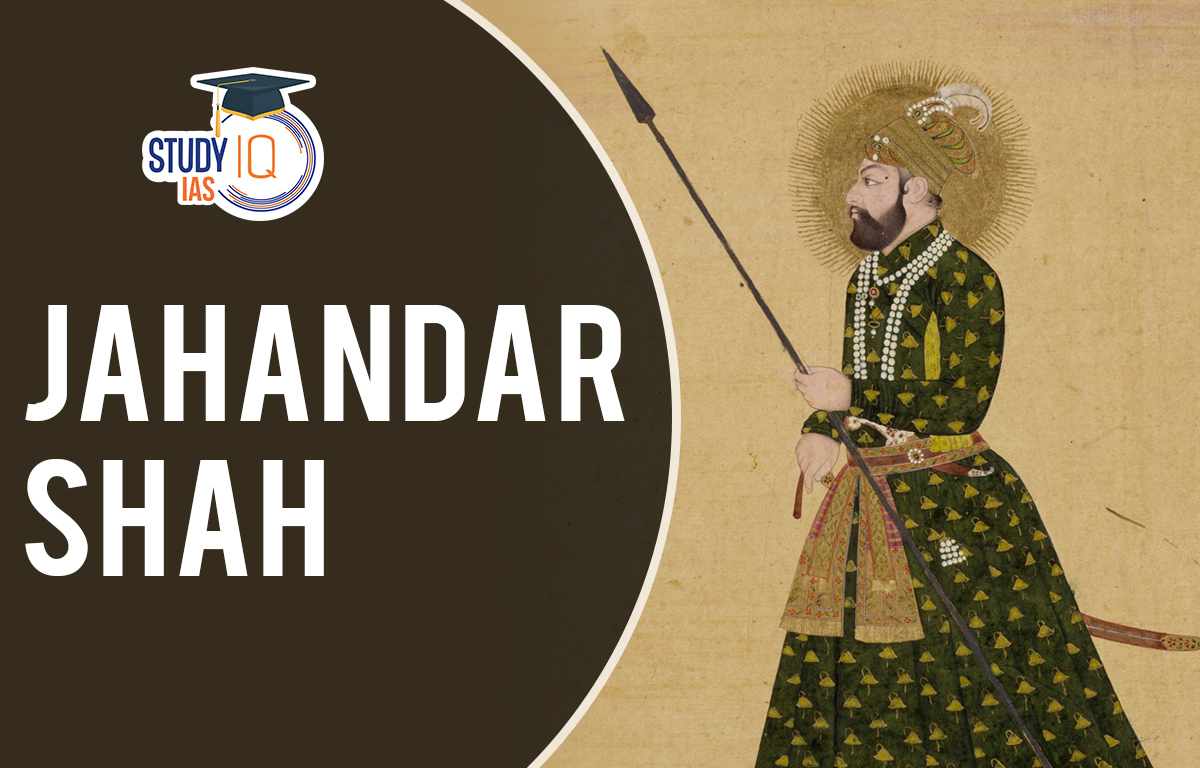Table of Contents
Jahandar Shah Introduction
Read complete details about Jahandar Shah. The Mughal Emperor Jahandar Shah, also known as Mirza Muhammad Mu’izz-ud-Di, ruled from 1712 to 1713. Abu’l Fath Mu’izz-ud-Din Shahanshahi His full name was Muhammad Jahandar Shah Sahib-i-Qiran Padshah-i-Jahan. Prince Jahandar Shah was born in Deccan Subah as the son of Emperor Bahadur Shah I. His mother was Nizam Bai, a lord’s daughter from Hyderabad named Fatehyawar Jang.
You will learn about Jahandar Shah (1712–1713) in this article, which will help with your preparation for the UPSC Civil Service Exam.
Read about: Decline of Mughal Empire
Jahandar Shah Early Life
Prince Jahandar Shah was born in Deccan Subah as the son of Emperor Bahadur Shah I. His mother was Nizam Bai, a princess from Hyderabad who was the daughter of Fatehyawar Jang. His great-grandfather Aurangzeb appointed Jahandar Shah as the vizier of Balkh in 1671. He and his brother, Azim-ush-Shan, declared themselves emperors and fought for the throne after their grandfather passed away on February 27, 1712.
On March 17, 1712, Azim-us-Shan was killed; Jahandar Shah thereafter ruled for an additional eleven months. Before ascending to the throne, Jahandar Shah sailed across the Indian Ocean and was a prosperous businessman. Additionally, he received the title of Sindh Subedar. One of his three sons, Aziz-ud-Din, who reigned as the Mughal emperor from 1754 to 1759, was born to him.
Read about: Later Mughal
Jahandar Shah Reign(1712 – 1713 AD)
When Bahadur Shah died in 1712, the Mughal Empire was once more forced into a civil war and a fight for power. The nobles had only helped the pretenders to the throne, whereas earlier the struggle for power had been between royal princes. However, now that the ambitious nobility were directly vying for positions of government, they employed Mughal princes to do it. The most powerful noble at the time was Zulfiqar Khan.
Zulfiqar Khan’s backing allowed Jahandar Shah, one of Bahadur Shah’s sons, to prevail in the civil war. Jahandar Shah was a depraved, weak prince who lived only for pleasure. He lacked respectability, decorum, and decency. Zulfiqar Khan was appointed Jahandar Shah’s wazir, and he effectively controlled the government.
In order to boost his status at the Court and preserve the Empire, Zulfiqar Khan thought it was essential to build cordial ties with the Rajput rajas, Hindu chieftians, and Maratha sardars. He made the following significant moves in this direction:
- The jizya tax was eliminated.
- Jai Singh of Amber was appointed governor of Malwa and given the title of Mirza Raja Sawai.
- Ajit Singh of Marwar was made Gujarat’s governor and given the title of Maharaja.
- The chauth and sardeshmukhi of the Deccan were given to the Maratha king with the agreement that they would be collected by Mughal officials and subsequently given to Maratha authorities.
- He made peace with Chhatarsal Bundela and Churaman Jat.
Jahandar Shah Coin Age
Jahandar Shah issued gold, silver, and copper coins as well as restored couplets. Abu al-Fateh and Sahab Qiran, two couplets, were used. Two weight standards for copper coins were produced: 20 g and 14 g. The gold mohur, which was issued by Jahandar Shah and struck in Mustaqir ul-Mulk, also known as the “Abode of the Kingdom”.
Jahandar Shah Ijarah System
The Ijarah system involved giving the highest bidder a defined work in exchange for a one-time payment. It was frequently used throughout the Mughal era. The Ijarah system, a method of revenue farming, was created by Jahadar Shah (1712 to 1713). The ijarah method of income assessment and collection gained popularity in the 18th century.
The fields were farmed out on ijarah to a third party called revenue farmers when peasants lacked the resources to develop their land or when cultivation was impossible due to a natural disaster. For tax officials or their family members, purchasing land on Ijarah was forbidden.
It was anticipated that revenue farmers would only extract from peasants the specified amount of land revenue. The revenue farmer kept the remaining sum as collection charges and paid the government nine tenths of the total amount collected.
Jahandar Shah UPSC
Bahadur Shah I’s son Jahandar Shah ruled for a brief period of time. After their father passed away on February 27, 1712, he and his brother Azim-ush-Shan proclaimed them emperors and got into a power struggle over the succession. Lal Kanwar, who had considerable influence over him, and the monarch, spent most of their time together in luxury and pleasure. This article contains all the information you need to know about Jahandar Shah for the UPSC Exam.


 Nagari Pracharini Sabha Revival: Backgro...
Nagari Pracharini Sabha Revival: Backgro...
 Ryotwari System in India, Features, Impa...
Ryotwari System in India, Features, Impa...
 Battle of Plassey, History, Causes, Impa...
Battle of Plassey, History, Causes, Impa...





















